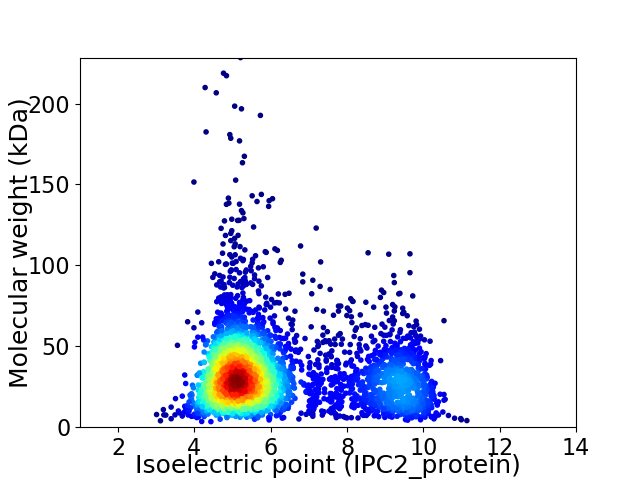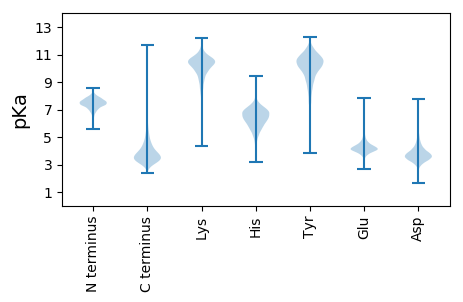
Arthrobacter sp. NEB 688
Taxonomy: cellular organisms; Bacteria; Terrabacteria group; Actinobacteria; Actinomycetia; Micrococcales; Micrococcaceae; Arthrobacter; unclassified Arthrobacter
Average proteome isoelectric point is 6.21
Get precalculated fractions of proteins

Virtual 2D-PAGE plot for 3724 proteins (isoelectric point calculated using IPC2_protein)
Get csv file with sequences according to given criteria:
* You can choose from 21 different methods for calculating isoelectric point
Summary statistics related to proteome-wise predictions



Protein with the lowest isoelectric point:
>tr|A0A6M8H6I3|A0A6M8H6I3_9MICC ABC transporter ATP-binding protein OS=Arthrobacter sp. NEB 688 OX=904039 GN=HL663_02540 PE=4 SV=1
MM1 pKa = 7.9SDD3 pKa = 3.44LEE5 pKa = 4.37YY6 pKa = 10.11PAGLRR11 pKa = 11.84YY12 pKa = 7.7TAEE15 pKa = 4.27HH16 pKa = 5.42EE17 pKa = 4.53WVRR20 pKa = 11.84EE21 pKa = 3.71EE22 pKa = 4.23AGVVRR27 pKa = 11.84IGITAFAQEE36 pKa = 4.0ALGDD40 pKa = 3.84VVYY43 pKa = 11.21VSLPAVGTTVTAGDD57 pKa = 3.41TCGEE61 pKa = 4.21VEE63 pKa = 4.37STKK66 pKa = 10.75SVSDD70 pKa = 3.79LYY72 pKa = 11.45APVAGEE78 pKa = 3.9VTAVNDD84 pKa = 4.22ALDD87 pKa = 3.97ATPEE91 pKa = 4.17LVNSDD96 pKa = 4.01PYY98 pKa = 11.46GEE100 pKa = 3.73GWMYY104 pKa = 10.45EE105 pKa = 4.25LRR107 pKa = 11.84PADD110 pKa = 4.09DD111 pKa = 3.95AAVAALLDD119 pKa = 3.5VDD121 pKa = 4.89AYY123 pKa = 10.62RR124 pKa = 11.84AQLSS128 pKa = 3.56
MM1 pKa = 7.9SDD3 pKa = 3.44LEE5 pKa = 4.37YY6 pKa = 10.11PAGLRR11 pKa = 11.84YY12 pKa = 7.7TAEE15 pKa = 4.27HH16 pKa = 5.42EE17 pKa = 4.53WVRR20 pKa = 11.84EE21 pKa = 3.71EE22 pKa = 4.23AGVVRR27 pKa = 11.84IGITAFAQEE36 pKa = 4.0ALGDD40 pKa = 3.84VVYY43 pKa = 11.21VSLPAVGTTVTAGDD57 pKa = 3.41TCGEE61 pKa = 4.21VEE63 pKa = 4.37STKK66 pKa = 10.75SVSDD70 pKa = 3.79LYY72 pKa = 11.45APVAGEE78 pKa = 3.9VTAVNDD84 pKa = 4.22ALDD87 pKa = 3.97ATPEE91 pKa = 4.17LVNSDD96 pKa = 4.01PYY98 pKa = 11.46GEE100 pKa = 3.73GWMYY104 pKa = 10.45EE105 pKa = 4.25LRR107 pKa = 11.84PADD110 pKa = 4.09DD111 pKa = 3.95AAVAALLDD119 pKa = 3.5VDD121 pKa = 4.89AYY123 pKa = 10.62RR124 pKa = 11.84AQLSS128 pKa = 3.56
Molecular weight: 13.54 kDa
Isoelectric point according different methods:
Protein with the highest isoelectric point:
>tr|A0A6M8GKW3|A0A6M8GKW3_9MICC Mycothiol system anti-sigma-R factor OS=Arthrobacter sp. NEB 688 OX=904039 GN=HL663_08965 PE=4 SV=1
MM1 pKa = 7.4GSVIKK6 pKa = 10.42KK7 pKa = 8.47RR8 pKa = 11.84RR9 pKa = 11.84KK10 pKa = 9.22RR11 pKa = 11.84MAKK14 pKa = 9.41KK15 pKa = 9.87KK16 pKa = 9.7HH17 pKa = 5.84RR18 pKa = 11.84KK19 pKa = 8.56LLRR22 pKa = 11.84KK23 pKa = 7.78TRR25 pKa = 11.84HH26 pKa = 3.65QRR28 pKa = 11.84RR29 pKa = 11.84NKK31 pKa = 9.78KK32 pKa = 9.85
MM1 pKa = 7.4GSVIKK6 pKa = 10.42KK7 pKa = 8.47RR8 pKa = 11.84RR9 pKa = 11.84KK10 pKa = 9.22RR11 pKa = 11.84MAKK14 pKa = 9.41KK15 pKa = 9.87KK16 pKa = 9.7HH17 pKa = 5.84RR18 pKa = 11.84KK19 pKa = 8.56LLRR22 pKa = 11.84KK23 pKa = 7.78TRR25 pKa = 11.84HH26 pKa = 3.65QRR28 pKa = 11.84RR29 pKa = 11.84NKK31 pKa = 9.78KK32 pKa = 9.85
Molecular weight: 4.08 kDa
Isoelectric point according different methods:
Peptides (in silico digests for buttom-up proteomics)
Below you can find in silico digests of the whole proteome with Trypsin, Chymotrypsin, Trypsin+LysC, LysN, ArgC proteases suitable for different mass spec machines.| Try ESI |
 |
|---|
| ChTry ESI |
 |
|---|
| ArgC ESI |
 |
|---|
| LysN ESI |
 |
|---|
| TryLysC ESI |
 |
|---|
| Try MALDI |
 |
|---|
| ChTry MALDI |
 |
|---|
| ArgC MALDI |
 |
|---|
| LysN MALDI |
 |
|---|
| TryLysC MALDI |
 |
|---|
| Try LTQ |
 |
|---|
| ChTry LTQ |
 |
|---|
| ArgC LTQ |
 |
|---|
| LysN LTQ |
 |
|---|
| TryLysC LTQ |
 |
|---|
| Try MSlow |
 |
|---|
| ChTry MSlow |
 |
|---|
| ArgC MSlow |
 |
|---|
| LysN MSlow |
 |
|---|
| TryLysC MSlow |
 |
|---|
| Try MShigh |
 |
|---|
| ChTry MShigh |
 |
|---|
| ArgC MShigh |
 |
|---|
| LysN MShigh |
 |
|---|
| TryLysC MShigh |
 |
|---|
General Statistics
Number of major isoforms |
Number of additional isoforms |
Number of all proteins |
Number of amino acids |
Min. Seq. Length |
Max. Seq. Length |
Avg. Seq. Length |
Avg. Mol. Weight |
|---|---|---|---|---|---|---|---|
0 |
1223339 |
31 |
2118 |
328.5 |
34.93 |
Amino acid frequency
Ala |
Cys |
Asp |
Glu |
Phe |
Gly |
His |
Ile |
Lys |
Leu |
|---|---|---|---|---|---|---|---|---|---|
13.77 ± 0.053 | 0.654 ± 0.01 |
6.339 ± 0.032 | 5.539 ± 0.04 |
2.524 ± 0.028 | 9.588 ± 0.035 |
2.203 ± 0.023 | 2.596 ± 0.03 |
1.623 ± 0.032 | 10.418 ± 0.057 |
Met |
Asn |
Gln |
Pro |
Arg |
Ser |
Thr |
Val |
Trp |
Tyr |
|---|---|---|---|---|---|---|---|---|---|
1.712 ± 0.018 | 1.436 ± 0.024 |
5.879 ± 0.033 | 2.45 ± 0.02 |
8.185 ± 0.049 | 5.12 ± 0.031 |
6.303 ± 0.038 | 10.359 ± 0.045 |
1.574 ± 0.016 | 1.728 ± 0.02 |
Most of the basic statistics you can see at this page can be downloaded from this CSV file
Proteome-pI is available under Creative Commons Attribution-NoDerivs license, for more details see here
| Reference: Kozlowski LP. Proteome-pI 2.0: Proteome Isoelectric Point Database Update. Nucleic Acids Res. 2021, doi: 10.1093/nar/gkab944 | Contact: Lukasz P. Kozlowski |
